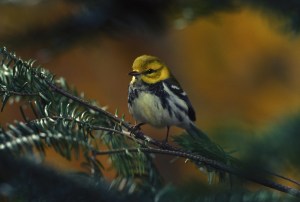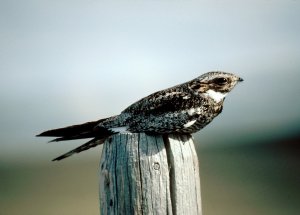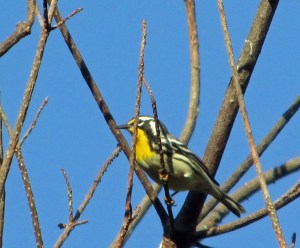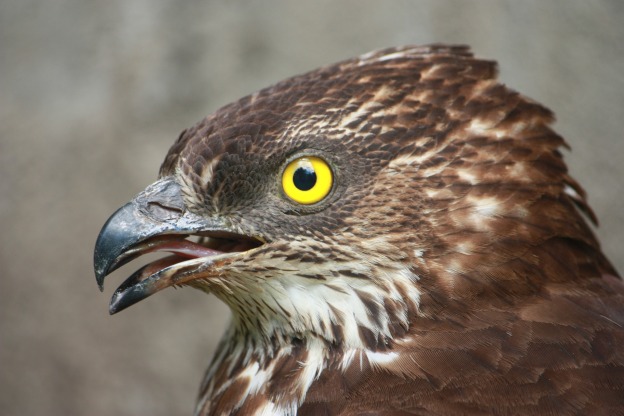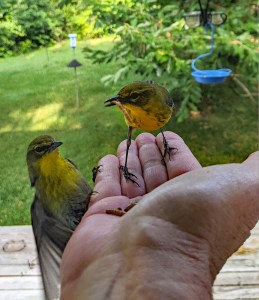
Photo by Rebecca Boyd • Pine warblers Petey and Petunia take mealworms from a waiting hand. These two warblers have learned to trust Rebecca “Becky” Boyd in order to get a quick meal.
For Becky Boyd, the ongoing pandemic has provided an unexpected opportunity to get to know some of her resident birds on a more personal basis. She has even won the trust of some of her backyard birds, succeeding at persuading them to take food right from her hands. She has posted photographs of some of these up close and personal engagements with birds to her Facebook page, where I first began to look with awe at her success.
Boyd, who resides in Knoxville, Tennessee, discussed some of her incredible stories involving some of her own feathered friends. “First, I feel like I should explain my bird-feeding station,” she said. “My bedroom window is on the second story, adjacent to a deck.”
She noted that there is a flower box under the window that she placed a board across so that she could set food containers right outside the window. “I also have a mealworm feeder hanging from a swing arm near this window,” Becky said.
She removed the screen covering the window so that she could pull the window open to take pictures up close. “This window is next to my home office work desk, where I sit every day during the COVID pandemic while working from home,” Becky continued. “The birds have become accustomed to seeing me at the window, and the first bird that I was able to feed by hand was a ruby-throated hummingbird.”
The process didn’t take all that much effort. “I got one of those little ‘button’ feeders’ that I held out the window next to the regular feeder,” she explained. “After a half dozen attempts, it worked!”
She added that she was even able to take a video of the experience.
Boyd also spoke about her relationship with the Eastern bluebirds living in her yard. “I have a bonded pair of bluebirds that live in my yard year round, and produce three broods of babies every year,” she said. “During time periods when natural food is scarce and when they are raising offspring, I provide live mealworms in addition to dried mealworms.”
She also has a section of a tree limb with recessed holes in which she spreads Wild Birds Unlimited’s Bark Butter (a specially formulated suet) onto. The limb hangs from a hook outside the same window.

Photo by Rebecca Boyd • Petey the pine warbler grabs a mealworm from a waiting hand. Petey’s trust eventually helped introduce his mate, Petunia, to the concept of a “free lunch” at the Knoxville home of Rebecca Boyd.
Most birding enthusiasts know that bluebirds and hummingbirds are among the most trusting of birds in regard to people, but Becky has enjoyed success with some species that are usually more aloof. For instance, the limb with the “bark butter” attracted the notice of a male pine warbler earlier this year.
“Sometimes when I would spread new butter on the stick, he would flutter around close by, being impatient to get something to eat,” she explained. “A few times he landed on my hand or arm during the process.”
Then the warbler discovered the little white dish that Becky keeps filled with live mealworms intended for the bluebirds. “At first, I would reach out to take the bowl away,” she said. “Live worms are sort of expensive.”
But the persistent warbler, who she named Petey, started landing on the lip of the bowl while she held it in her hand to protect the mealworms for the bluebirds.
“Once he associated that white bowl with yummy live worms, he started watching from a nearby tree for me to open the window to put out worms,” Becky said. “He would fly over immediately to grab some.”
His forward nature inspired her to conduct an experiment.
“Often, he would helicopter over the bowl in my hand with impatience, so I tried keeping the bowl in my hand instead of setting it on the ledge,” Becky continued. “He adapted right away, and before long his mate, Petunia, started copying his behavior.”
Becky expanded the experiment. “Within a week or so, I decided to try just putting the worms in the palm of my hand instead of in the bowl,” she said. “Petey adapted right away, but Petunia was a bit more reluctant.”
Becky noted with pride that Petey will perch on her hand for quite a while to gobble up some worms for himself. He will then grab a few in his beak to take back to the nest for their offspring.
“Petunia is more tentative and strategic, and will typically land just long enough to grab a few worms,” Becky said. “I’ve noticed that oftentimes they will take their worms and squish them into the bark butter or dunk them in the birdbath before taking them back to the nest. I wonder if that makes the worms stop wiggling to make it easier for the babies to eat them.”
Becky assumed that the warblers would only eat from her hand stuck out through the window opening, but one day she was sitting in a lawn chair in her back yard.

Photo by Rebecca Boyd • Pine warbler Petey ducks his beak into a bowl of mealworms for a quick snack.
“Petey found me and started fluttering around looking for food,” she recalled. “He followed me back to the house and waited on the deck ledge for me to fetch him some worms.”
He has become quite insistent. “When I would sit on the deck to read or watch the birds, he would land on the table and trill at me with a loud, shrill song until I met his requirements,” Becky said.
Now, when she is sitting at her desk working, Petey often gets her attention by pecking on the window to let her know he’s there and waiting for worms.
“So, I keep a cup with some worms next to the window so I can quickly slide the window open and shake a few into my hand to offer him,” Becky said. “Once the first brood of fledglings started coming to the window, they chose to only eat the bark butter instead of gravitating to the mealworm feeder.”
Becky added that the fledglings have moved on now, and Petey and Petunia are working on their second brood.
Becky has some aspirations about other resident birds. “I would love to be able to hand-feed the bluebirds,” she shared. “They will come very close to me — sometimes almost nose to beak through the closed window — but they are not willing to get close enough to hand-feed.”
She has had some success getting a few of her resident tufted titmice to accept food from her hands. Petey and Petunia deserve some of the credit.
“The titmice watched how the pine warblers ate from my hand and picked up the routine very quickly,” Becky said. “One of them is so bold, I sometimes have to try to shake him off my hand like he’s a housefly, but he comes right back to latch onto my fingers!”
She often names some of the regular cast of characters among her feathered friends.
Pine warbler pair Petey and Petunia have raised two fledglings, which Becky dubbed Posey and Pansy.
She has given her Eastern bluebird pair the names of Bogie and Bacall.
“They lost all but one fledgling from their first brood this year, so I named her Solo,” Becky added. “This pair has nested in my yard for four years in a row.
Her two reliable ruby-throated hummingbirds have been given the names LeRoy and Loretta.

Photo by Jean Potter • A pine warbler visits a seed feeder at the home of Brookie and Jean Potter near Wilbur Lake in Elizabethton, Tennessee.
I asked if she has ever been described as a “bird whisperer” by her friends. “All the time!” Becky responded. “Many of my friends and Facebook Birding Group members are as amazed as I am about this experience.
Becky noted that her backyard attracts a wide variety, as well as volume, of birds. “I try to make it attractive to the birds versus pretty for the people,” she said. “I always keep two clean birdbaths available to them, and consistently keep feeders full of different types of seeds.”
In addition, she said that she plants bird-loving trees and shrubs and even left a couple of dead trees standing in the yard for the woodpeckers to enjoy. “I also try to make myself visible to the birds on a regular basis so that they understand that I’m not a threat,” Becky said. “I’m not sure if I have an actual gift, or if this is all just a wonderful result of spending so much time at home in their environment.”
Her special encounters with backyard birds provides a “rewarding feeling of awe and intrigue,” she said. “Having such a personal relationship with wild birds deepens my awareness of nature and makes me even more determined to help our songbird populations survive and thrive. That being said, I do recognize that wild birds should not be tamed such that they lose their fear of humans. Understanding this risk, I feel a mixture of joy and a little guilt. I don’t plan to encourage this behavior with any new birds, but I sure am enjoying my bond with this pine warbler pair.
Friends don’t always fully understand her enthusiasm for birds.
“Some don’t understand my passion for this or recognize how rare it is to have a personal relationship with wild birds, but most of my friends are also nature lovers who are in awe of this and wish they could do it, too,” Becky said.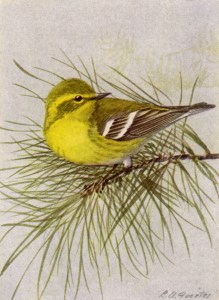
“I joke that I should build a solid fence around my property and charge admission to my bird park,” Becky said. “My friends have encouraged me to start my own website to display and sell my bird photos, and I am in the process now of building my website, which will be named RidgeRockArts.com.”
In the meantime, Petey is on the verge of achieving a taste of international fame.
“An accomplished artist in Amsterdam recently saw one of my photos of Petey perched on my hand and asked to paint him to add to her portfolio,” Becky said.
Petey even crowded into the interview’s conclusion. “Here he is right now pecking on the window during this interview,” Becky said. “I must stop what I’m doing and get him a handful of worms right this instant. I think he is the one that trained me versus me training him.”















